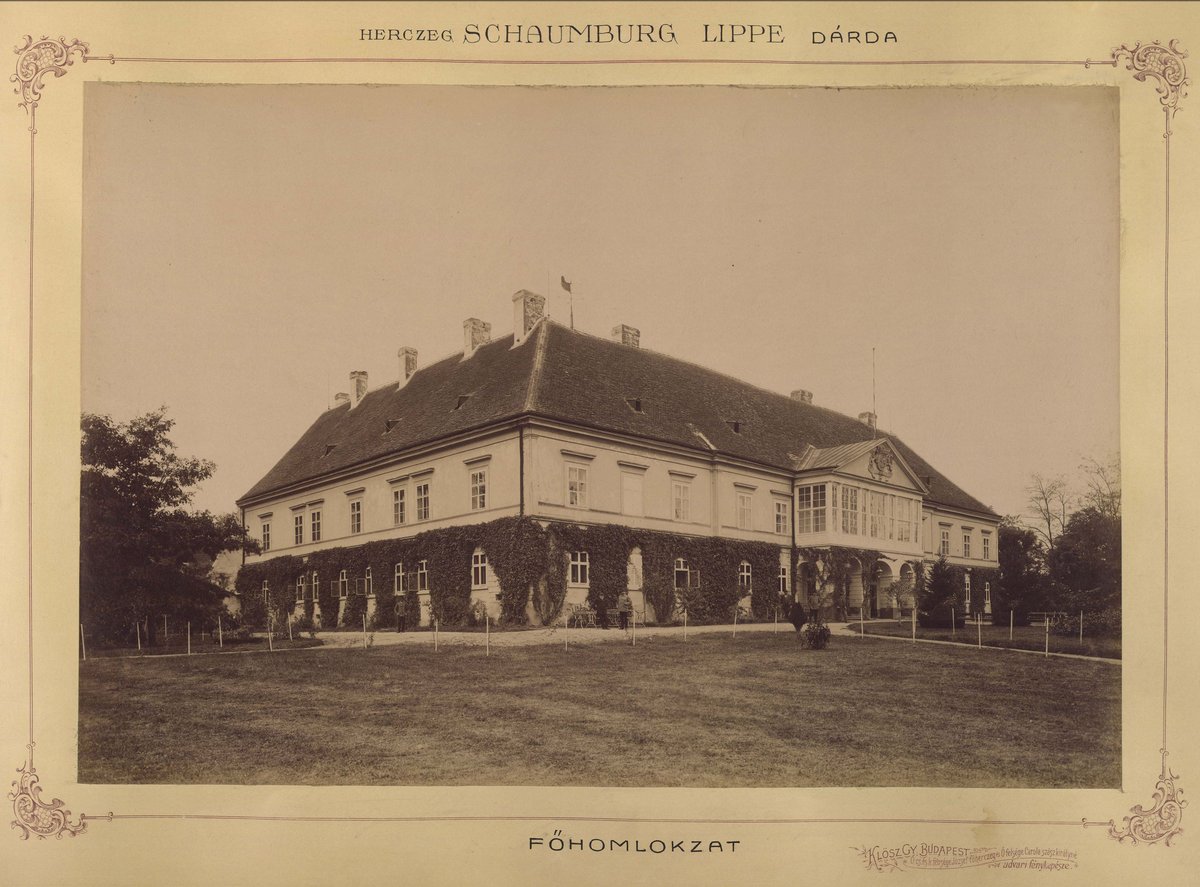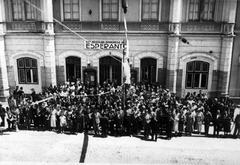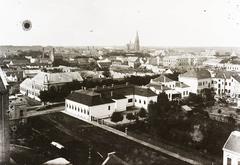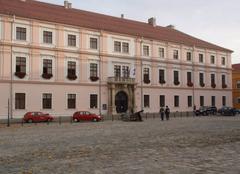
Comprehensive Guide to Visiting Dvorac Esterhazy, Osijek, Croatia
Date: 22/07/2024
Introduction
Dvorac Esterhazy, also known as Esterhazy Palace, stands as a monumental testament to the rich cultural and historical heritage of Osijek, Croatia. Constructed in the 18th century by the influential Esterhazy family of Hungary, this palace embodies the grandeur of Baroque architecture with its ornate façade, grand staircases, and intricately decorated interiors (Osijek Tourism). The Esterhazy family, prominent patrons of the arts, significantly influenced the cultural landscape of Central Europe, including employing the renowned composer Joseph Haydn for over three decades. This historical landmark has played a vital role in regional politics and has been a center for numerous cultural events and political meetings during the Austro-Hungarian Empire (Esterhazy Palace Tours). Today, Dvorac Esterhazy serves as a museum and cultural venue, offering visitors a glimpse into the past through its well-preserved architecture and historical exhibits. This guide aims to provide detailed information on the history, significance, and visitor logistics of Dvorac Esterhazy, ensuring an enriching and memorable experience.
Table of Contents
- Introduction
- Origins and Early History
- Construction and Architectural Style
- The Esterhazy Family’s Influence
- Role in Regional Politics
- Changes in Ownership
- Impact of World War II
- Post-War Restoration Efforts
- Modern-Day Significance
- Cultural Events and Activities
- Visitor Information
- Nearby Attractions
- Travel Tips
- Preservation and Future Plans
- FAQ
- Conclusion
Origins and Early History
Dvorac Esterhazy, constructed in the 18th century by the prominent Esterhazy family of Hungary, stands as a testament to the family’s influence in Central Europe. Their impact extended into Croatia during the Habsburg Monarchy’s rule, making the palace a significant historical landmark.
Construction and Architectural Style
The construction of Dvorac Esterhazy began in the early 1700s and was completed in 1721. Designed in the grand Baroque architectural style, the palace features an ornate façade, grand staircases, and elaborately decorated interiors, embodying the dramatic use of light and shadow characteristic of the period.
The Esterhazy Family’s Influence
The Esterhazy family was a major patron of the arts, notably employing the composer Joseph Haydn for over three decades. While Haydn primarily worked at their main residence in Eisenstadt, Austria, their cultural influence permeated their properties in Croatia, including Dvorac Esterhazy.
Role in Regional Politics
Throughout the 18th and 19th centuries, Dvorac Esterhazy served as a political and administrative center. The palace hosted numerous significant political meetings and events, symbolizing the Esterhazy family’s authority and close ties with the Habsburg monarchy.
Changes in Ownership
The late 19th and early 20th centuries saw the decline of the Esterhazy family’s fortunes, leading to the sale of Dvorac Esterhazy. The palace changed hands multiple times, with various owners making modifications and renovations.
Impact of World War II
World War II significantly impacted Dvorac Esterhazy. Occupied by various military forces, the palace suffered damage from bombings and military occupation, leading to the loss of many original architectural features and artworks.
Post-War Restoration Efforts
Post-war restoration efforts aimed to repair war damage and preserve the palace’s historical significance. These initiatives, supported by the Croatian government and international heritage organizations, helped restore Dvorac Esterhazy to its former glory.
Modern-Day Significance
Today, Dvorac Esterhazy is a prominent cultural landmark in Osijek. Open to the public as a museum, the palace showcases the history and heritage of the Esterhazy family and the region. Visitors can explore the grand ballroom, library, and various exhibition rooms displaying historical artifacts and artworks.
Cultural Events and Activities
Dvorac Esterhazy hosts cultural events such as concerts, art exhibitions, and historical reenactments. Its gardens and grounds are popular venues for outdoor events, providing a picturesque setting for weddings, festivals, and other celebrations.
Visitor Information
Visiting Hours
The palace is open daily from 9 AM to 5 PM. It is advisable to check the official website for any seasonal changes in the visiting hours.
Ticket Prices
General admission is $10, with discounts for students and seniors. Children under 12 can enter for free.
Guided Tours
Guided tours are available in multiple languages; booking in advance is recommended to ensure availability.
Accessibility
The palace is wheelchair accessible, with ramps and elevators available.
Nearby Attractions
In addition to Dvorac Esterhazy, visitors to Osijek can explore several other attractions in the area. These include the Osijek Fortress, a well-preserved 18th-century fortification, and the Church of St. Peter and St. Paul, a stunning example of Gothic Revival architecture. The city also offers a variety of museums, galleries, and parks, providing plenty of opportunities for cultural and recreational activities (Osijek Tourist Board).
Travel Tips
Best Time to Visit
Spring and fall offer pleasant weather and fewer crowds, making these seasons ideal for visiting.
Photography
The palace offers numerous photographic spots, especially in the gardens and grand ballroom. However, the use of flash and tripods is generally prohibited to protect the artworks and furnishings.
Local Cuisine
Don’t miss trying local Croatian dishes at nearby restaurants. Popular choices include “Kod Ruže” for local specialties and “Muzej Okusa” for a fine dining experience (Osijek Restaurants).
Preservation and Future Plans
Ongoing preservation efforts are crucial to maintaining Dvorac Esterhazy’s significance. Future plans include expanding museum exhibits, enhancing visitor facilities, and promoting the palace as a key tourist destination in Osijek. These efforts have been supported by various organizations, including the Croatian Ministry of Culture and the European Union.
FAQ
What are the visiting hours for Dvorac Esterhazy?
The palace is open daily from 9 AM to 5 PM. Check the official website for the most current hours.
How much are the tickets?
General admission is $10, with discounts for students and seniors. Children under 12 can enter for free.
Is the palace accessible for people with disabilities?
Yes, the palace is wheelchair accessible.
Are guided tours available?
Yes, guided tours are available in multiple languages; booking in advance is recommended.
Conclusion
Dvorac Esterhazy is more than just a historical landmark; it is a living repository of the rich cultural and political history that has shaped Osijek and its surroundings. From its Baroque architectural splendor to its pivotal role in regional politics, the palace offers a multifaceted glimpse into the past. Modern-day visitors can explore its grand interiors, participate in cultural events, and enjoy the beautifully landscaped gardens. The ongoing preservation efforts underscore the importance of maintaining this historical gem for future generations. Whether you are a history enthusiast, an architecture aficionado, or simply a curious traveler, Dvorac Esterhazy promises a captivating experience (Osijek Tourist Board). By following the practical tips and information provided in this guide, you can make the most out of your visit to this iconic palace. Stay updated with the latest events and exhibitions by following Dvorac Esterhazy on social media and visiting the official Esterhazy Palace website.
References
- Dvorac Esterhazy - Exploring the Rich History and Visiting Hours of Osijek’s Landmark, 2024, Author Osijek Tourism
- Explore Dvorac Esterhazy - Visiting Hours, Tickets, and Historical Insights, 2024, Author Esterhazy Palace Tours
- Visitor Tips for Dvorac Esterhazy - Tickets, Hours, and Travel Guide to Osijek’s Historical Gem, 2024, Author Osijek Tourist Board





